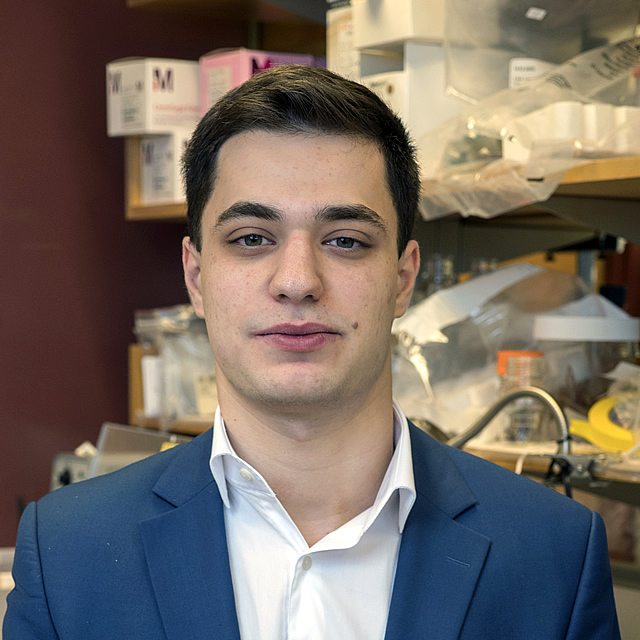
Trainee Spotlight: Daniel Sultanov
-

Daniel Sultanov
Graduate Student
Dr. Vasily Studisky’s lab
Fox Chase Cancer Center
[email protected]
linkedin.comBiography
During my childhood years, I found myself being really interested in biology and chemistry, which turned into a serious and passionate hobby in middle school. To satiate my hunger for knowledge and learn about life at the most basic to the most complex levels, I decided to pursue a career in biology. Consequently, I enrolled at Moscow State University, an acclaimed university in Russia, renowned for its accessible facilities and expertise in aspects of biology, notably in molecular biology, biochemistry and cell biology. As a sophomore, I gained hands-on experience in a lab when studying mammary adenocarcinoma in mouse models and discovered a deep love of applied research. Although this experience marked only my first exposure to lab work, I was hooked! After volunteering at an animal facility, I decided to dig deeper into cancer research focusing on chromatin structure, specifically how the structure is often altered in cancer cells. To this end, I began work on my Bachelor Degree project, studying how poly (ADP-ribose) polymerase 1 (PARP-1)—a protein involved in DNA repair, transcription and chromatin organization—recognizes DNA breaks in nucleosomes. During my studies, I met Dr. Vasily Studitsky, who was co-mentoring my PARP-1 project. In 2016, after receiving my Bachelor’s diploma in biology with honors, I joined Dr. Studisky’s lab at Fox Chase Cancer Center (FCCC) to pursue my Master’s degree. Being at FCCC has been a unique opportunity to continue my previous studies on the interaction of PARP-1 and damaged chromatin. My current work focuses on how nucleosomes are remodeled by PARP-1 near double-stranded DNA breaks, which is a completely new action for PARP-1. As PARP-1 is a recently approved therapeutic target in BRCA1-deficient breast and ovarian cancer, I believe that my findings will help improve existing anti-cancer therapies.
Research Overview
The eukaryotic genome is organized into nucleosomes: 147 base pairs of DNA segments wrapped around a core of eight histone proteins. An important consequence of this organization is that DNA accessibility to various proteins, including those involved in DNA repair, is limited. To increase DNA accessibility, ATP-dependent chromatin remodelers reorganize chromatin by introducing torsions into the DNA superhelix, which leads to shifting or replacing of the histone octamer along the DNA strand. The action of these chromatin remodelers is especially important during DNA repair, when improper processing of double-strand breaks can lead to aberrant genome structures and, eventually, the accumulation of mutations and cancer. PARP-1 is an abundant multi-domain protein that plays a crucial role in the early detection of single- and double-strand DNA breaks through the DNA-binding zinc-finger domains. The interaction of PARP-1 with DNA breaks results in its DNA-dependent activation and poly(ADP)-ribosylation of the target proteins (including auto modification of PARP-1) using NAD+ as a substrate. Using single-particle FRET microscopy, together with biochemical assays, we showed that PARP-1 binds to the break in nucleosomal DNA and reversibly unfolds the nucleosomes. This finding has never been reported before and has a potentially significant value because it could clarify the initial remodeling stages of damaged chromatin, and facilitate downstream processing of DNA damage.
Featured Publications
Sultanov, D., Gerasimova, N., Kudryashova, K., Maluchenko, N., Kotova, E., Langelier, M.-F., Pascal, J., Kirpichnikov, M., Feofanov, A., and Studitsky, V. Unfolding of core nucleosomes by PARP-1 revealed by spFRET microscopy. AIMS Genetics, 4(1):21–31, 2017. PubMed
Gerasimova, N., Valieva, M., Sultanov, D., Kudryashova, K., Maluchenko, N., Kotova, E., Kirpichnikov, M., Studitsky, V., and Feofanov, A. Complexes of nucleosomal nanoparticles with proteins: spFRET microscopy study of Olaparib and PARP-1 binding to core nucleosomes. Microscopy and imaging science: practical approaches to applied research, 55–61, 2017. PubMed
